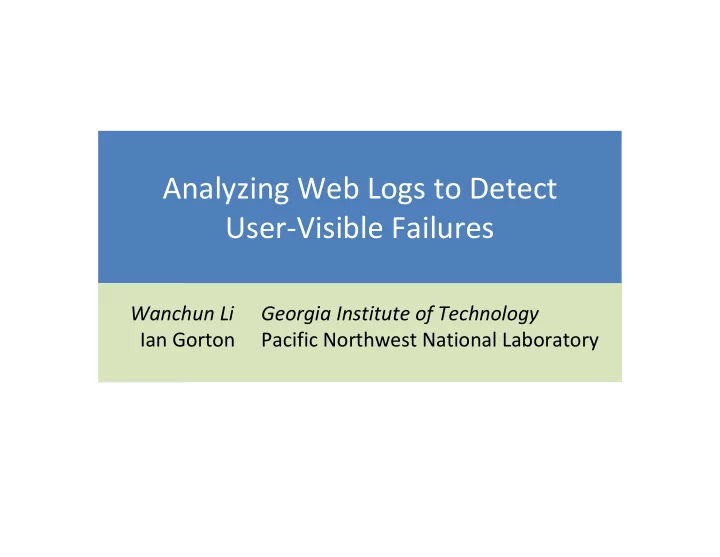

Analyzing Web Logs to Detect User-Visible Failures Wanchun Li Georgia Institute of Technology Ian Gorton Pacific Northwest National Laboratory
Road Map I. Introduction II. Technique III. Model Training IV. Evaluation V. Discussion VI. Conclusion
INTRODUCTION • Web applications suffer from poor reliability � Top 40 Web sites about 10 days of downtime per year � 32% of shoppers experienced online shopping problems during the 2006 holiday season � 89% of all online customers experienced errors Practitioners rely on fast failure detection and recovery to reduce the effects of failures on other users.
INTRODUCTION • Early failure detection can mitigate about 65% of failures • Failure detection is challenging � Requires up to 75% of failure recovery time • User feedback has limited help for detecting failures � User survey of www.clinicalguard.com in 2008 • 200 users • 9 responses • 1 specified the failure
Existing Detection Techniques • Resource usages analysis � Constructing statistics using data of resources usage • Focusing on performance failures • Not on failures related to software bugs • Runtime components interaction analysis � Detecting runtime execution path anomalies � Not always effective to software bugs • User-behavior-based analysis � Analyzing request bursts to a URL/resource • Assume users refreshing browsers for failures � Users have different behavior than refreshing
Road Map I. Introduction II. Technique III. Model Training IV. Evaluation V. Discussion VI. Conclusion
Overview The Goal: Detecting failures caused by software bugs Assumptions HCI Rational Principle Users must respond if the result of a sequence of interactions is not satisfactory Navigation Patterns • Web users follow certain navigation patterns • Users’ response to failures may break these patterns The Idea: Detecting anomalous navigation paths as indications that users encountered failures
The Model • A directed graph representing a Web site � Nodes are Web pages � Edges are users’ navigation S={A, B, C, C, D, A, D} A Markov model in the 1 st order for estimating • the probability of a navigation path � The transition probability to the next state is conditionally dependent on only the current state P[AB]=P[A]P[B|A] P[S]=P[A]P[B|A]P[C|B] P[C|C] P[D|C] P[A|D] P[D|A]
Transition Probability • Two types of transition probability � Outgoing Transition Probability (OTP) The probability that users go from page A to page B � Incoming Transition Probability (ITP) The probability that users at page B coming from page A • OTP usually is different from ITP � A user can navigate to the Home page from any page � But not vice versa
Occurrence Probability for Failure Detection � Given a sequence of user requests � Compute the occurrence probability � Using 1 st -order Markov model � Outgoing Occurrence Probability (OOP) The occurrence probability computed using OTP � Incoming Occurrence Probability (IOP) The occurrence probability computed using ITP If min (OOP, IOP) < threshold Raise a failure alarm
Road Map I. Introduction II. Technique III.Model Training IV. Evaluation V. Discussion VI. Conclusion
Bayesian Learning • Assume � The parameter to estimate is a random variable • Estimate � The distribution of the parameter as a random variable � A statistic as the estimator • Process � Assume a distribution of the parameter � Find a conjugate prior distribution � Compute the posterior distribution • Update the prior distribution using the training data � Decide an estimator • posterior mean : the mean of the posterior distribution
Bayesian Learning Transition Probability • Bayesian Learning to train a First-order Markov Model � A Multinomial distribution � A Direchlet distribution as the conjugate prior • Learn Outgoing/Incoming Transition Probability • The learning process • A small amount of training data for setting prior • The rest training data for updating prior • The posterior mean as the estimator
Estimated Transition Probability Estimated OTP from state i to state j All hits on state i in data for setting the prior Transitions from i to j in data for setting the prior All hits on state i in the rest training data Transition frequency from i to j in the rest training data
Road Map I. Introduction II. Technique III. Model Training IV.Evaluation V. Discussion VI. Conclusion
Subject • NASA Web site • Construct user-sessions using one month access log � 1,891,714 HTTP requests from real users • Training data Prior: 572 user-sessions on 1 st day � Learning: 2404 user-sessions on 2 nd to 10 th day � • Testing data � 7941 non-error sessions for detection � 500 error sessions for false positive
Result Equal Error Rate (i.e., EER): the decision boundary when detection and false-positive have the same loss function. Our model’s EER=0.71/0.26
Road Map I. Introduction II. Technique III. Model Training IV. Evaluation V. Discussion VI. Conclusion
Discussion • Improving the detection power � Semi-Markov model (e.g., time) � Hidden state • The “ground truth” � Error sessions as user-visible failures • More case studies � Controlled environments • Recruit users • Instrument real-world Web sites
Road Map I. Introduction II. Technique III. Model Training IV. Evaluation V. Discussion VI.Conclusion
Conclusion • Detecting User-visible failures � Improving both reliability and user’s satisfaction • User’s behavior changes when encounter failures � Breaking navigation patterns • Our technique detects anomaly user navigation paths • The experiment results demonstrate our technique can detect failures with reasonable cost • Future work aims at model improvements and case studies
Thank You!
Recommend
More recommend